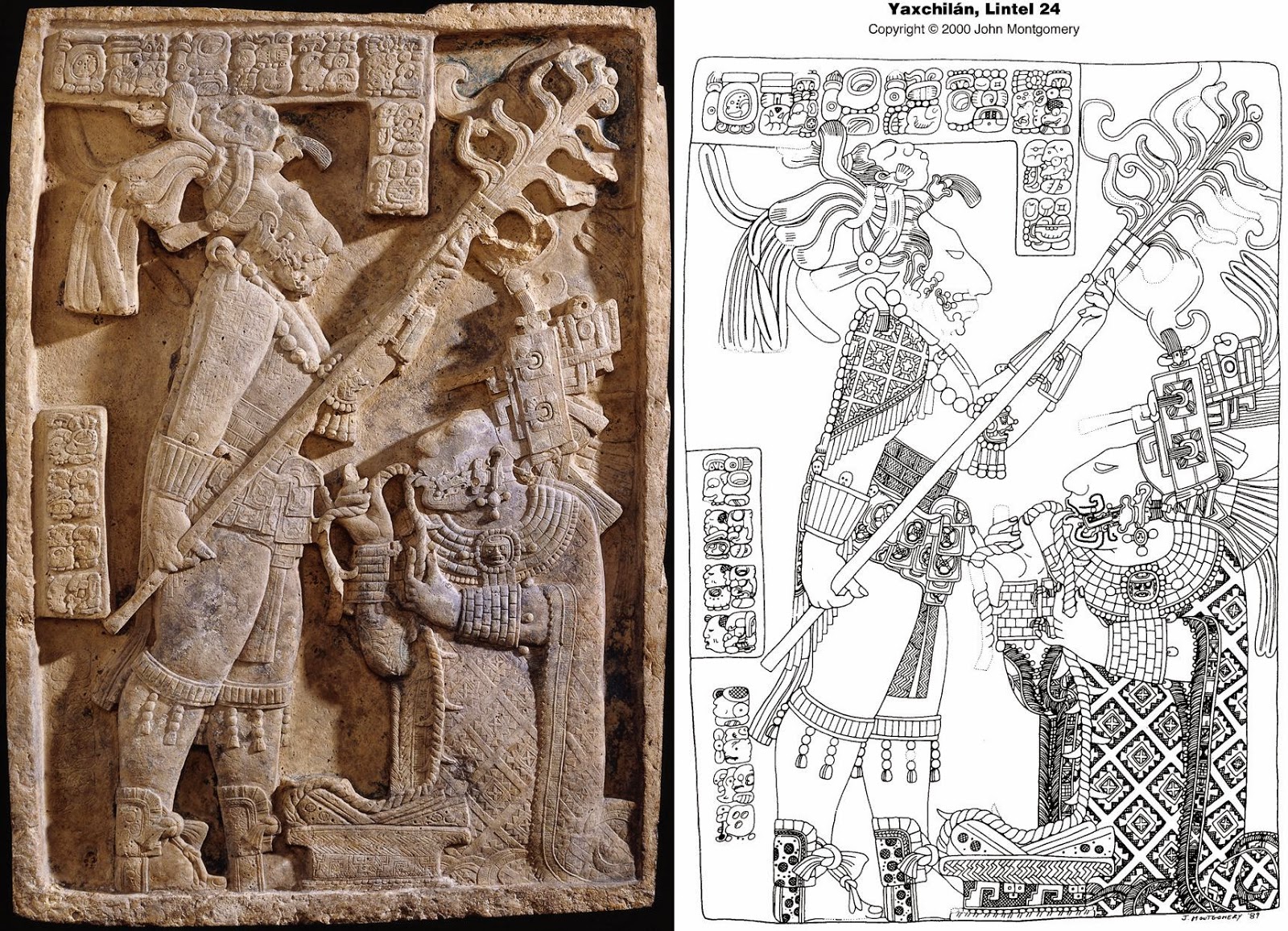'Cookie Cutter Master': Lintel 24 in Yaxchilán (A.D. 725)
(British Museum, London, UK)
This is one of the great masterpieces of Maya art. I
present the orginal lintel (left) with a great drawing of John Montgomery of
this lintel to clarify all the details of this amazing piece of art. What we
are seeing here is is a bloodletting ritual. The bloodletting was the
ritualized self-cutting or piercing of an individual's body. This ritual was
associated with the elite among the Maya. A Maya king would draw blood in many
occasions such as every event of political or religious importance, dedication of
a building, couples marries or the dead burried, children born etc. The idea
behind this ritual was that human blood was partially made up of the blood of
the gods, who sacrificed their own divine blood in creating life in humans.
Thus, in order to continually maintain the order of their universe, the Maya
believed that blood had to be given back to the gods. So the sacrifice
symbolized the renewal of divine energy and, in doing so, the continuation of
life.
The standing figure is Itzamnaaj Bʻalam II (or Shield Jaguar II), the Maya king of Yaxchilan. The kneeling figure is Lady Kʻabʻal Xook or Lady Xoc. She was the wife of king Shield Jaguar. King Shield Jaguar is hold a torch which suggest that the scene is either taking place at night or in a dark room. The king has his hair bond together with quetzal feathers which shows that he also will draw blood, in his case from his penis. The king wears a finely woven pleated cape and has a necklace of the Sun god. Attached to his head band is a representation of the Jester Mask, which is a symbol for kingship. The king also has a shrunken head of a past sacrificial victim attached to his headband. This is a symbol that the King is able to provide sustenance to the gods. Lady Xoc is performing the bloodletting ritual by pulling a rope with attached thorns or obsidian flakes through her mutilated tongue. The rope itself falls into a woven basket, which holds a bloodsoaked paper and a stingray spine (Shield Jaguar will use this spine for his ritual). The symbols aroung Lady xoc's mounth symbolize her blood. Lady Xoc is dressed in a magnificent woven huipil which has a complex pattern and is rimmed with fringe and pearls. She has head band with a a mosaic depiction of Tlaloc (The God of rain, fertility, and water) sprouting quetzal feathers. Her wrist cuffs are made from shell or jade plaques and she also has a necklace of the Sun God.
The text gives us the names of both the King and Queen and also the date that this ritual had taken place. In this case it took place on the Maya date 9.13.17.15.15 5 Eb 15 Mac which is October 28, A.D. 709. The text also tells us that King Shield Jaguar had lived into his fourth katun which means that he was between 60 and 80 years old during this ritual. The text doesn't gives us the reason for the bloodletting. Also interesting is the lower set of text which gives us the name of the master (or workshop) who made this lintel, an artist/ workshop known as 'the cookie cutting master'. This lintel was made in A.D. 725.
The standing figure is Itzamnaaj Bʻalam II (or Shield Jaguar II), the Maya king of Yaxchilan. The kneeling figure is Lady Kʻabʻal Xook or Lady Xoc. She was the wife of king Shield Jaguar. King Shield Jaguar is hold a torch which suggest that the scene is either taking place at night or in a dark room. The king has his hair bond together with quetzal feathers which shows that he also will draw blood, in his case from his penis. The king wears a finely woven pleated cape and has a necklace of the Sun god. Attached to his head band is a representation of the Jester Mask, which is a symbol for kingship. The king also has a shrunken head of a past sacrificial victim attached to his headband. This is a symbol that the King is able to provide sustenance to the gods. Lady Xoc is performing the bloodletting ritual by pulling a rope with attached thorns or obsidian flakes through her mutilated tongue. The rope itself falls into a woven basket, which holds a bloodsoaked paper and a stingray spine (Shield Jaguar will use this spine for his ritual). The symbols aroung Lady xoc's mounth symbolize her blood. Lady Xoc is dressed in a magnificent woven huipil which has a complex pattern and is rimmed with fringe and pearls. She has head band with a a mosaic depiction of Tlaloc (The God of rain, fertility, and water) sprouting quetzal feathers. Her wrist cuffs are made from shell or jade plaques and she also has a necklace of the Sun God.
The text gives us the names of both the King and Queen and also the date that this ritual had taken place. In this case it took place on the Maya date 9.13.17.15.15 5 Eb 15 Mac which is October 28, A.D. 709. The text also tells us that King Shield Jaguar had lived into his fourth katun which means that he was between 60 and 80 years old during this ritual. The text doesn't gives us the reason for the bloodletting. Also interesting is the lower set of text which gives us the name of the master (or workshop) who made this lintel, an artist/ workshop known as 'the cookie cutting master'. This lintel was made in A.D. 725.
